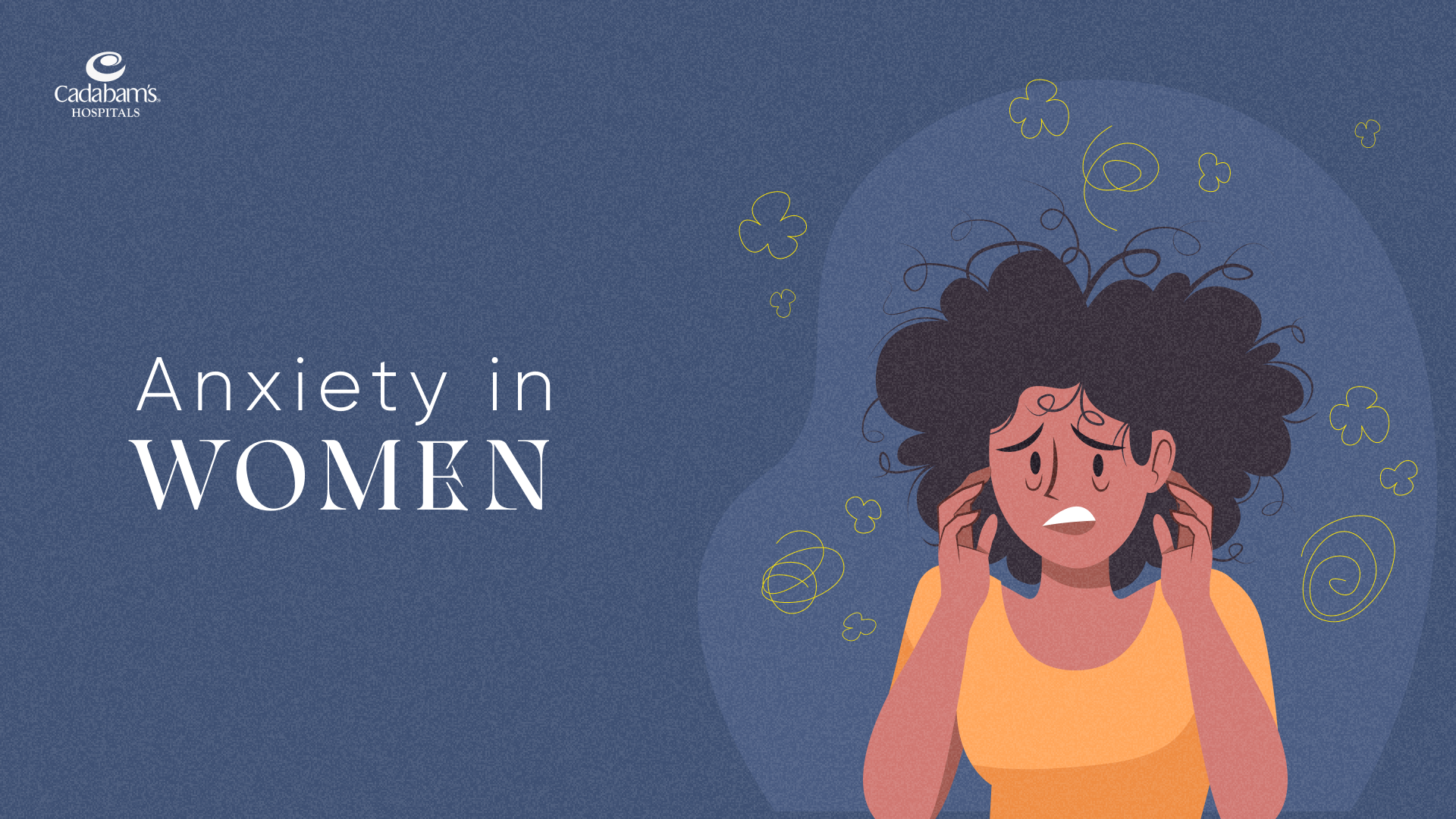Table of Content
Anxiety is something that we all face from time to time, but it has been found to be more predominant among women. Let’s look at this in detail.
A racing heart, clammy palms, scattered thoughts, and an overwhelming sense of unease – these are the telltale signs of anxiety. For an estimated 264 million individuals globally, anxiety disorders cast a long shadow over their lives.
Anxiety, as defined by the American Psychological Association (APA), is a complex emotional state marked by tension, relentless worry, and accompanying physical alterations. In the contemporary landscape, women, in particular, find themselves wrestling with these symptoms of anxiety all too frequently.
In this blog, we delve into the intricacies of anxiety in women, shedding light on its unique facets and exploring strategies to cope with and conquer this prevalent issue. Join us as we embark on a journey to understand and address anxiety in the lives of women today.
Understanding Anxiety Disorders
We've all felt that familiar butterflies or restlessness before a nerve-wracking presentation or a visit to the dentist. These mild jitters are part of the body's evolutionary response, a connection to the fight-or-flight mechanism. Anxiety triggers the release of adrenaline and other hormones, boosting our energy and optimising our systems to prioritise lung and heart functions. This natural chain reaction serves a purpose in moderation but can become overwhelming in individuals with generalised anxiety disorder (GAD). According to Dianne Chambless, PhD, a psychology professor at the University of Pennsylvania, anxiety itself isn't problematic. It's when it escalates to a severe degree, impinging on one's quality of life, work, relationships, and overall well-being, that it transforms into a disorder.
How Anxiety in Women Differs: Exploring Gender-Specific Challenges
Anxiety is a common mental health challenge that affects individuals of all genders, but anxiety in women is often influenced by distinctive life experiences. Hormonal fluctuations during key phases such as puberty, pregnancy, and menopause make women particularly vulnerable. These changes can heighten the risk of anxiety disorders, with conditions like perinatal anxiety emerging during pregnancy and the postpartum period.
Several types of anxiety are particularly unique to women:
- Puberty Anxiety: As young women undergo significant hormonal changes during puberty, they become more susceptible to anxiety. While boys and girls typically experience similar anxiety rates before puberty, adolescent girls are more likely than boys to develop anxiety once puberty hits.
- Premenstrual Dysphoric Disorder (PMDD): PMDD manifests as depressive mood and anxiety in the week leading up to menstruation. It can include symptoms like fatigue, concentration difficulties, sleep disturbances, physical discomfort, and joint pain.
- Prenatal Anxiety: Approximately 6% of women experience anxiety during pregnancy, marked by hormonal shifts and the stress of impending motherhood.
- Postpartum Anxiety: Around 10% of postpartum women grapple with anxiety in the first year after childbirth, sometimes alongside depression.
- Menopausal Anxiety: Menopause, like puberty, involves significant hormonal changes and can predispose women to anxiety, particularly those experiencing symptoms like hot flashes and insomnia. Hormone therapy may offer relief in some cases.
Why is Anxiety in Women More Common?
Anxiety in women is a significant mental health concern, with women being over twice as likely as men to experience it during their lifetimes. This heightened prevalence is often accompanied by comorbid conditions, such as experiencing anxiety and depression simultaneously.
Women are especially prone to disorders like generalized anxiety disorder (GAD), panic disorder, specific phobias, and post-traumatic stress disorder (PTSD). The impact of anxiety in women is particularly pronounced due to hormonal and environmental factors.
Hormonal factors play a critical role in these differences. Oestrogen fluctuations during key life stages, along with consistently lower testosterone levels in women, contribute to their increased susceptibility. Furthermore, the impact of stress—often tied to traumatic experiences—affects women disproportionately, leaving them more vulnerable to anxiety disorders, particularly PTSD.
Understanding these unique challenges is essential for developing targeted support and effective treatment strategies for anxiety in women.
What Causes Anxiety in Women?
Anxiety in women is a complex condition influenced by shared causes across genders and specific factors that increase their vulnerability. These encompass:
- Abuse and Neglect: Experiencing abuse or neglect, especially during childhood, can develop anxiety later in life.
- Family History: A family history of anxiety or a close relative grappling with anxiety can increase the likelihood of developing anxiety.
- Personal History: A personal history of anxiety or other mental health concerns can heighten susceptibility.
- Physical Health Conditions: Coping with a severe physical ailment like cancer can be emotionally taxing and trigger anxiety.
- Stressful Life Events: Traumatic occurrences such as the loss of a loved one, job loss, or divorce can provoke anxiety.
Nevertheless, certain triggers are unique to women.
Types of Anxiety Disorders Common in Women
Anxiety disorders affect women in unique ways, with certain types being more prevalent or manifesting differently due to biological and social factors. Below are common types of anxiety disorders seen in women:
Generalised Anxiety Disorder (GAD)
GAD involves persistent and excessive worry about everyday situations, such as work, health, or family. Women with GAD often experience physical symptoms like fatigue and muscle tension alongside constant overthinking.
Panic Disorder
Panic disorder is characterized by recurring panic attacks, sudden episodes of intense fear, and physical symptoms such as chest pain and shortness of breath. Women are more likely to report these attacks and fear future episodes.
Social Anxiety Disorder (SAD)
SAD, or social phobia, involves intense fear of judgment or embarrassment in social situations. Women with SAD may avoid gatherings, public speaking, or new interactions, impacting their personal and professional lives.
Specific Phobias
Specific phobias are intense fears of particular objects or situations, such as heights, animals, or enclosed spaces. These fears are often more pronounced in women, leading to avoidance behaviors that can limit daily activities.
Obsessive-Compulsive Disorder (OCD)
OCD is marked by intrusive thoughts (obsessions) and repetitive behaviors (compulsions). Women may experience OCD related to contamination fears, perfectionism, or concerns about safety, often heightened by caregiving roles.
Post-Traumatic Stress Disorder (PTSD)
PTSD occurs after exposure to traumatic events and is more common in women, often linked to experiences like abuse or assault. Symptoms include flashbacks, nightmares, and emotional numbness, impacting overall well-being.
Recognising these disorders and their prevalence in women helps in tailoring effective treatments and support strategies.
Hormonal Factors and Anxiety
Throughout their lives, women experience hormonal variations tied to different life stages—puberty, menstruation, pregnancy, childbirth, and menopause. These fluctuations are believed to contribute to anxiety during these periods.
- Puberty: Pubescent girls undergo not only physical changes but also face challenges such as peer pressure, social media concerns, and academic stress. Coupled with significant hormonal shifts, these factors can foster anxiety.
- Menstruation: Monthly menstrual cycles subject women to hormonal ups and downs, impacting mood and causing irritability. Premenstrual Syndrome (PMS) and Premenstrual Dysphoric Disorder (PMDD) can exacerbate anxiety symptoms.
- Pregnancy and Childbirth: Hormonal changes during pregnancy and postpartum, known as the 'perinatal period,' can trigger perinatal anxiety. Concerns may revolve around childbirth, baby preparation, or dealing with conditions like hyperemesis gravidarum (HG). Postpartum anxiety can persist in the year following childbirth.
Social and Cultural Influences
Women naturally produce more stress hormones than men, making them susceptible to anxiety in response to stressful situations like divorce or bereavement. Along with that, contemporary women often juggle numerous responsibilities, from full-time work to household management and childcare. These multiple demands can overwhelm and contribute to anxiety and depression.
Life Transitions and Anxiety
Transitioning through life changes prompts a natural resistance to the unfamiliar, as revealed by a 2012 literature review. Nicole Sbordone, a licensed clinical social worker in Scottsdale, Arizona, explains that as creatures of habit, we find solace in routine. When this stability is disrupted by uncertainty, anxiety can take hold. The brain craves familiarity, and moments of transition often bring discomfort, fueling anxious feelings. Embracing change means adapting to a new way of life, acknowledging the innate resistance, and working towards finding balance amidst the uncertainty.
Common Anxiety Symptoms in Women
Anxiety disorders are genuine medical conditions that, like physical ailments such as asthma and hypertension, respond well to treatment. Understanding that anxiety disorders are treatable is vital, as these conditions can significantly impact daily life quality. Given that anxiety affects more women than men, recognising its symptoms in women is crucial.
Symptoms of anxiety disorders can vary from one individual to another but often include:
- Digestive Distress: Ongoing nausea, reduced appetite, and abdominal pain may occur.
- Increased Heart Rate: Heart rate elevation, particularly in stressful situations.
- Fatigue: Feelings of tiredness, lethargy, or weakness.
- Concentration Challenges: Difficulty focusing and maintaining attention.
- Dread and Panic: A sense of impending danger or doom.
- Irritability: Nervousness and edginess.
- Sleep Disturbances: Insomnia and other sleep-related issues.
- Physical Symptoms: Trouble with rapid breathing, sweating, and trembling.
While these are indicative of anxiety in women, it's important to note that they can also overlap with symptoms of substance use disorders. Anxiety is a normal response to stress or danger, but when these responses disrupt daily life without a genuine threat, an anxiety disorder evaluation is warranted. If you or a loved one exhibits these symptoms and relies on substances like alcohol to alleviate them, seeking evaluation at a treatment centre capable of addressing both co-occurring disorders is essential, such as Caron.
Impact on Mental Health and Physical Health
Anxiety in women affects mental well-being by causing persistent worry, restlessness, and emotional strain. Physically, it can lead to issues like increased heart rate, digestive problems, and disrupted sleep, potentially escalating long-term health risks. Early intervention is crucial for overall well-being. A few points regarding the impact of anxiety on women’s mental and physical health are given below:-
- The intricate relationship between mental and physical health cannot be overstated. According to a study, positive psychological well-being can serve as a safeguard against heart attacks and strokes. Conversely, poor mental health can lead to detrimental physical health and risky behaviours.
- Chronic diseases are often intertwined with mental health conditions. Depression, for example, has been linked to diabetes, asthma, cancer, cardiovascular disease, and arthritis. Similarly, schizophrenia is associated with a higher risk of heart and respiratory diseases. Moreover, mental health issues can complicate the management of chronic illnesses, resulting in a higher mortality rate among those with concurrent depression or other mental health conditions.
- Sleep problems are a common companion to mental health conditions. Conditions like insomnia and sleep apnea affect a significantly higher percentage of individuals with mental health issues compared to the general population. Sleep disturbances may exacerbate existing mental health conditions while being exacerbated by them, creating a challenging cycle.
- Smoking is more prevalent among those with mental health conditions, with an increased likelihood of heavier smoking. This can be attributed to the lower dopamine levels in individuals with depression, as nicotine in cigarettes temporarily boosts dopamine production, offering momentary relief. However, this can lead to a recurring need to smoke and potential addiction.
- Access to healthcare is often compromised for individuals with mental health conditions, making it more challenging to manage their physical well-being. Seeking care, adhering to prescriptions, and maintaining a healthy lifestyle can be difficult when grappling with a mental health condition.
- Furthermore, physical health conditions can give rise to mental health challenges. Conditions like psoriasis, cancer, or heart attacks can trigger feelings of depression or anxiety, affecting approximately one-third of individuals with serious medical conditions. Emotional and psychological distress often stems from the stress, stigma, and rejection associated with these conditions, underscoring the intricate interplay between mental and physical health.
Effective Coping Strategies for Women to Manage Anxiety
Women can manage anxiety through consistent self-care practices such as mindfulness, regular exercise, and maintaining a balanced diet. Building a supportive network of friends and family helps reduce stress while setting boundaries promotes a healthy work-life balance. Seeking professional guidance through therapy or counseling offers tailored tools to address anxiety effectively. A few points regarding coping strategies are given below:-
- Coping strategies for women encompass a diverse range of techniques to navigate life's challenges effectively.
- Building a robust support network of friends and family can provide a valuable emotional safety net.
- Engaging in regular exercise not only promotes physical well-being but also helps manage stress and anxiety.
- Practicing mindfulness and relaxation techniques, such as meditation or yoga, can aid in reducing daily tension.
- Setting clear boundaries in personal and professional life helps maintain a healthy work-life balance.
- Additionally, seeking professional help through therapy or counselling can provide invaluable tools for managing anxiety, depression, or other mental health concerns, offering women the support they need to thrive.
How Professional Guidance Can Help Women Overcome Anxiety
Seeking professional support is a crucial step in managing mental health effectively. When faced with overwhelming anxiety, depression, or other mental health challenges, consulting a mental health professional offers expert guidance and treatment options. Psychologists, psychiatrists, therapists, and counsellors are trained to provide personalised strategies for coping and healing.
They can diagnose specific conditions, recommend therapy or medication when necessary, and offer a safe and confidential space for individuals to express their thoughts and feelings. Seeking professional help is a proactive and empowering choice that can lead to improved mental well-being and a better quality of life. Remember, there is no shame in seeking the support you deserve.
Overcoming Anxiety in Women: Expert Care and Guidance at Cadabam’s Hospitals
Anxiety in women is a multifaceted challenge shaped by hormonal changes, life transitions, societal pressures, and unique triggers. Throughout this guide, we’ve explored the symptoms, causes, and types of anxiety disorders in women, as well as their impact on mental and physical health. We’ve also highlighted effective coping strategies and the importance of professional guidance to manage and overcome anxiety.
Taking proactive steps like building a support network, practicing mindfulness, maintaining healthy routines, and seeking expert help can empower women to regain control and lead fulfilling lives. If you or someone you care about is struggling with anxiety, remember that support is available, and recovery is possible.
If you are searching for a solution to your problem, Cadabam’s Hospitals can help you with its team of specialised experts. We have been helping thousands of people live healthier and happier lives for 30+ years. We leverage evidence-based approaches and holistic treatment methods to help women to manage their anxiety.
Get in touch with us today. You can call us at +91 97414 76476. You can even email us at info@cadabamshospitals.com.
Frequently Asked Questions
1. What are the common symptoms of anxiety in women, and how do they differ from men?
Common symptoms of anxiety in women include persistent worry, physical tension, and social anxiety. Women may also experience fatigue, sleep issues, and muscle tightness, which differ from the irritability often seen in men. Recognising these symptoms of anxiety in women is essential for seeking effective support.
2. Are there any lifestyle factors that can contribute to anxiety in women, such as diet, exercise, or sleep patterns?
Yes, lifestyle factors like poor diet, lack of exercise, and disrupted sleep patterns can contribute to anxiety in women.
3. Are women more prone to certain types of anxiety disorders compared to men?
Yes, women are more prone to certain anxiety disorders, such as generalised anxiety disorder and panic disorder, compared to men.
4. What are the available treatment options for anxiety in women, and how effective are they?
Treatment options include therapy, medication, and lifestyle changes. Effectiveness varies, but therapy and medications like SSRIs can be highly effective.
5. How can family members and loved ones support women dealing with anxiety in their daily lives?
Offer emotional support, listen without judgment, encourage professional help, assist in seeking therapy or medication, promote self-care, and maintain open communication.
6. What are the signs of anxiety in women?
Signs of anxiety in women may appear as unease, lack of energy, or heightened sensitivity to stress. Other signs of anxiety in women include disrupted routines, inability to stay calm, or feeling overwhelmed in certain situations. Identifying these traits early can help in managing anxiety effectively.
How Cadabam's Help you for Addiction?
- 410+ Professional Consultants
- 1,00,00+ Happy Faces
- 120+ Currently Seeking Treatments









